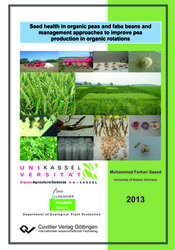| Fachbereiche | |
|---|---|
| Buchreihen (96) |
1379
|
| Nachhaltigkeit |
3
|
| Gesundheitswesen |
1
|
| Geisteswissenschaften |
2367
|
| Naturwissenschaften |
5407
|
| Mathematik | 229 |
| Informatik | 319 |
| Physik | 980 |
| Chemie | 1364 |
| Geowissenschaften | 131 |
| Humanmedizin | 243 |
| Zahn-, Mund- und Kieferheilkunde | 10 |
| Veterinärmedizin | 108 |
| Pharmazie | 147 |
| Biologie | 835 |
| Biochemie, Molekularbiologie, Gentechnologie | 121 |
| Biophysik | 25 |
| Ernährungs- und Haushaltswissenschaften | 45 |
| Land- und Agrarwissenschaften | 1004 |
| Forstwissenschaften | 201 |
| Gartenbauwissenschaft | 20 |
| Umweltforschung, Ökologie und Landespflege | 148 |
| Ingenieurwissenschaften |
1793
|
| Allgemein |
98
|
|
Leitlinien Unfallchirurgie
5. Auflage bestellen |
|
Erweiterte Suche
Seed health in organic peas and faba beans and management approaches to improve pea production in organic rotations
Muhammad Farhan Saeed (Autor)Vorschau
Leseprobe, PDF (78 KB)
Inhaltsverzeichnis, PDF (59 KB)
Peas (Pisum sativum L.) and faba beans (Vicia Faba L.) are important cool season legume crops, highly nutritious and used for soil fertility management in rotation systems for ecological N enrichment of fields. A survey of organic pea and faba bean seeds in organic agriculture from 2009 to 2012 indicates that seed-borne pathogens (Ascochyta blight complex and Fusarium spp.) are common but not high. The relationship between the seedlot infestation or environmental factors and infestation levels of the harvested seeds were weak pointing to the importance of soil-borne and potentially also wind borne inoculum. In past several cultural practices were studied singly and found partially effective. In this thesis the effects of a management approach combining biofumigation cover crops, mixed cropping and reduced tillage was tested for its effects on pea health under organic field conditions. Field trials were established twice on different fields with differencing in their soil types from 2009-2012. Different weather conditions also influenced the system performance. In both runs weeds were reduced by 50 % in the mixtures compared to the pure stands of peas. Reductions of pea yields due to reduced tillage were statistically significant in 2011 (29 %) but reduction was non significant in 2010 (21 %). Reductions due to mixing with oats were 30 % in 2010 and >50 % in 2011. Brassica cover crops had variable effects on yields and no differing effects on pea diseases. Nitrogen leftovers were low after all treatments. In 2010-11, wheat performed better after peas, but not in 2011-2012 in the overall better soil. Pea-oat intercropping at low seed rate with reduced tillage can be a useful tool to suppress weeds due to a more efficient use of available N resources and competition against weeds by oats. Reduced tillage with mixed cropping has no detrimental effects on pea root health but may reduce infestation of aphids. Conclusions about the effects of this system with reduced tillage should only be drawn from longer-term experiments, however, as it is known that major changes will occur in soils for several years after changing tillage practices.
| ISBN-13 (Printausgabe) | 9783954044405 |
| ISBN-13 (E-Book) | 9783736944404 |
| Buchendformat | A5 |
| Sprache | Englisch |
| Seitenanzahl | 234 |
| Umschlagkaschierung | matt |
| Auflage | 1. Aufl. |
| Erscheinungsort | Göttingen |
| Promotionsort | Kassel |
| Erscheinungsdatum | 11.06.2013 |
| Allgemeine Einordnung | Dissertation |
| Fachbereiche |
Land- und Agrarwissenschaften
|
| Schlagwörter | Ascochyta blight complex, Weed suppression, organic pea and faba bean, seed/soil-borne diseases, Biofumigation, brassica cover crop, pea-oat mixed/inter cropping, reduced tillage, pea foot and root diseases, pea aphid, organic rotation |
| URL zu externer Homepage | http://www.uni-kassel.de/fb11agrar/en/sections/oekologischer-pflanzenschutz/research/dissertationen.html |








